Danny Love's Farrier's Corner

Teaching Your Horse to
Stand Quietly for the Farrier
Part One
Your horse will have to have his feet handled, trimmed and/or shod all his life.
He needs to stand calmly for the farrier. There is no excuse for horses who pull their
feet away from the farrier or push the farrier around. Aside from the nuisance factor and
wasted time, such antics can result in injury to the horse or farrier. Plus, this is a problem
which can easily be corrected.
Materials Needed
You will need an open area in which to work, a hand tied "horseman's" rope training halter, a 12 ft. 3/4 inch kernmantle braid horse handling rope and a "wand". (A wand is a usually a light colored crop or longe whip which has the tassle taped to the body so that it doesn't fly. Dark crops or whips are suitable for this exercise since the horse won't be "following" the wand while moving.)
Setting Up the Exercise
Your horse has to be able to longe capably on a lead. The logic of this training is that when he pulls or shoves
on the farrier, he will be cued to longe a minimum of two and a maximum of 4 laps. The horse will not learn the
behavior modification if you also have to teach him how to longe at the same time you are trying to alleviate the bad behavior.
He has to associate cooperating with
the farrier with relaxation and pulling away or shoving on the farrier with work. Furthermore, when longing, the horse
is expected to move properly and we would handle him as we would with any longe lesson, so the time spent circling is not
wasted. Also, you need to call for at least two circles so that the horse's mind settles into the work,
but generally not more than four so that he doesn't lose the association with the behavior being modified.
Work out arrangements with your farrier in advance. He needs to lay out his
equipment so that you can cue the horse to longe the instant he pulls or pushes and
the farrier gives the order. Your circle shouldn't end up going over tools and stands,
and if necessary you can take a couple of steps back when you start the circle so the arc
is clear of equipment and obstructions.
Executing the Exercise
The subjects here are 3-year old Missy and farrier Ron Moritz. Ron
previously attempted to trim Missy by himself. Ron is a vary
capable farrier who handles horses well, however the precocious Missy was a
handful to work with. This time Sharon is handling Missy and they
have set up a "learn-learn" behavior modification session. Missy can
pull and lean if she wants to, but every time she does, she will be sent
out on a longe lesson which we call "taking two". Please note that this is a
longe lesson, not mindless circling, so this work may include working in
"ovals" or setting up a chain of reverses if Missy really needs to get focused.
Sharon takes Missy's head and leaves enough slack in the rope so that
Missy has some freedom to move around. She has the rope folded so that if
she sends Missy out into the circle, she can easily pay out the needed rope
so that the tranisition from standing for the farrier to longing at a
working trot is immediate.
Sharon also uses the wand to stroke Missy's legs and body just prior to
starting the farriery work and also rubs Missy lightly with the wand while
she is standing. Sharon and Ron have discussed how Ron will communicate when he
wants Sharon to send Missy off so there will be no confusion or delay. Ron
approaches Missy as he would any "veteran" horse.
With the distraction of Sharon's presence, it took Missy a little bit longer to get
fussy about her feet being worked on, but eventually she did try to pull away and
she was sent into the circle.
Getting results was really just this simple. Missy understood the association and out of free choice
decided to "hang out" with Ron rather than work in the circle. The entire remainder of the foot work, including
"bringing her forward" onto the stand to rasp off the toes, went without a hitch.
|
This 3 year old used to
shove the farrier around.
Yet after only a few minutes'
work, she is standing quietly
and cooperatively.
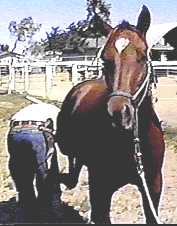
Ron drew this "famous" sketch
on the barn board after one
particularly rough day with Missy
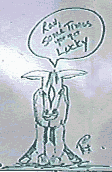
Missy is standing for Ron.
She can move her head if she
wants, so long as she doesn't
move her feet. Sharon is prepared
to send her out if necessary
and is also stroking Missy with
the wand.
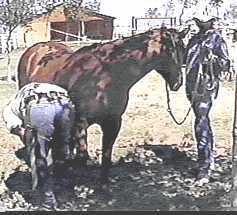
Before any of you take issue
about the handler being on one
side of the horse and she shoer
on the other, read the information
here. It simply doesn't matter.
The horse is not provoked to
"flight or fight," she can step
forward quietly if she needs to
and Ron is completely in charge
of the movement of the horse.
The farrier is in less danger
of being run over than when more
"traditional" methods are used.
(Most often there is no handler
and the leadrope is simply laid
over the horse's withers or tucked
in the farrier's belt.)
"Take two," Missy!
It only took three times being
sent out for Missy to get the
message and stand quietly for Ron.
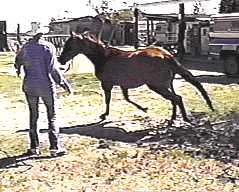
Here's Missy, so calm that she is yawning.
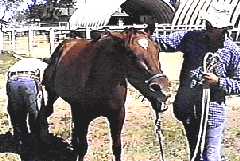
There is absolutely no
need for trimming feet to be
a hectic, harrowing and
dangerous experience.
Continue to:
|